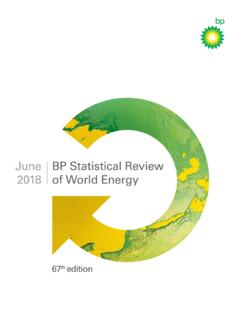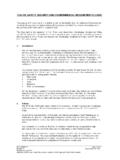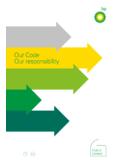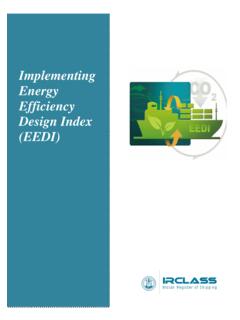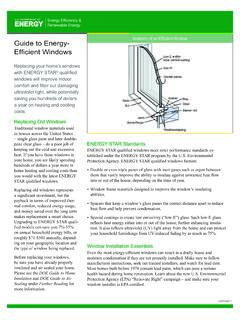Transcription of MIDDLE SCHOOL ENERGY EXPERIMENTS
1 MIDDLE SCHOOL ENERGY EXPERIMENTSINTERMEDIATE2 2015 The NEED Project 8408 Kao Circle, Manassas, VA 20110 the next generation of innovators Science, technology, engineering, and math (STEM) affect nearly every aspect of our lives from the cars we drive, to the food we eat, to the smartphones we use to communicate. Innovation is the key to helping the stay competitive in today s globalized, technology-driven world. As a result, STEM jobs are in high demand and typically pay significantly better than non-STEM fields. To fill the high-skilled jobs that will power the American economy in the future, the needs more students to study , BP depends on people with strong foundations in STEM to help solve the world s ENERGY challenges. These engineers, scientists, and other professionals find ways to produce and deliver the ENERGY that heats our homes, powers our schools, cooks our food, and fuels our cars.
2 The information and activities in this booklet will help you understand the important role STEM plays in the ENERGY industry. 2015 The NEED Project 8408 Kao Circle, Manassas, VA 20110 3 Student Text 4 Clean Air 6 Corroding Metals 7 Cryogenic Roses 8 ENERGY from Garbage 9 Cooling Fan 10 Heavy Backpacks 11 Insulation 12 Natural and Man-Made Fibers 13 Natural Herbicide 14 Natural Plastic 15 Saving Hot Water 16 Seeds and Needs 17 Solar Distillation 18 Waste Heat 19 Wind Around Your Home 20 Biodegradability 21 Insulating with Air 22 Absorbing Solar ENERGY 23 Table of Contents4 2015 The NEED Project 8408 Kao Circle, Manassas, VA 20110 Is ENERGY ? ENERGY makes change; it does things for us. It moves cars along the road and boats over the water. It bakes a cake in the oven and keeps ice frozen in the freezer.
3 It plays our favorite songs and lights our homes. ENERGY makes our bodies grow and allows our minds to think. Scientists define ENERGY as the ability to do of EnergyEnergy is found in different forms, such as light, heat, sound, and motion. There are many forms of ENERGY , but they can all be put into two categories: potential and ENERGY Potential ENERGY is stored ENERGY and the ENERGY of position, or gravitational potential ENERGY . There are several forms of potential ENERGY . Chemical ENERGY is ENERGY stored in the bonds of atoms and molecules. It is the ENERGY that holds these particles together. Biomass, petroleum, natural gas, propane, and the foods we eat are examples of stored chemical ENERGY . Elastic ENERGY is ENERGY stored in objects by the application of a force. Compressed springs and stretched rubber bands are examples of elastic ENERGY . Nuclear ENERGY is ENERGY stored in the nucleus of an atom; it is the ENERGY that holds the nucleus together.
4 The ENERGY can be released when the nuclei are combined or split apart. Nuclear power plants split the nuclei of uranium atoms in a process called fission. The sun combines the nuclei of hydrogen atoms in a process called fusion. Gravitational potential ENERGY is the ENERGY of position or place. A rock resting at the top of a hill contains gravitational potential ENERGY because of its position. Hydropower, such as water in a reservoir behind a dam, is an example of gravitational potential ENERGY . KINETIC ENERGY Kinetic ENERGY is motion; it is the motion of waves, electrons, atoms, molecules, substances, and objects. Electrical ENERGY is the movement of electrons. Everything is made of tiny particles called atoms. Atoms are made of even smaller particles called electrons, protons, and neutrons. Applying a force can make some of the electrons move. Electrons moving through a wire are called electricity. Lightning is another example of electrical ENERGY .
5 Radiant ENERGY is electromagnetic ENERGY that travels in vertical (transverse) waves. Radiant ENERGY includes visible light, x-rays, gamma rays, and radio waves. Solar ENERGY is an example of radiant to ENERGY Thermal ENERGY , or heat, is the internal ENERGY in substances; it is the vibration and movement of the atoms and molecules within a substance. The more thermal ENERGY in a substance, the faster the atoms and molecules vibrate and move. Geothermal ENERGY is an example of thermal ENERGY . Motion ENERGY is the movement of objects and substances from one place to another. Objects and substances move when an unbalanced force is applied according to Newton s Laws of Motion. Wind is an example of motion ENERGY . Sound ENERGY is the movement of ENERGY through substances in longitudinal (compression/rarefaction) waves. Sound is produced when a force causes an object or substance to vibrate; the ENERGY is transferred through the substance in a longitudinal of EnergyChemical EnergyElastic EnergyNuclearEnergyGravitationalPotentia l EnergyElectricalEnergyRadiantEnergyTherm alEnergyMotionEnergySoundEnergyPOTENTIAL KINETIC 2015 The NEED Project 8408 Kao Circle, Manassas, VA 20110 5 Conservation of EnergyYour parents may tell you to conserve ENERGY .
6 Turn off the lights, they say. To scientists, ENERGY conservation is not just about saving ENERGY . The Law of Conservation of ENERGY says that ENERGY is neither created nor destroyed. When we use ENERGY , it doesn t disappear. We change one form of ENERGY into another. A car engine burns gasoline, converting the chemical ENERGY in gasoline into motion ENERGY . Solar cells change radiant ENERGY into electrical ENERGY . ENERGY changes form, but the total amount of ENERGY in the universe stays the efficiency is the amount of useful ENERGY you get from a system. A perfect, ENERGY efficient machine would change all the ENERGY put in it into useful work a technological impossibility today. Converting one form of ENERGY into another form always involves a loss of usable ENERGY . Most ENERGY transformations are not very efficient. The human body is a good example of this. Your body is like a machine, and the fuel for your machine is food.
7 Food gives you the ENERGY to move, breathe, and think. Your body isn t very efficient at converting food into useful work. Most of the ENERGY in your body is transformed and released as thermal ENERGY (heat). You can really feel that heat when you exercise! This is very much like most ENERGY transfers. The loss of useable ENERGY is often in the form of thermal ENERGY (heat). Sources of EnergyWe use many different ENERGY sources to do work for us. They are classified into two groups renewable and nonrenewable. In the United States, most of our ENERGY comes from nonrenewable ENERGY sources. Coal, natural gas, petroleum, propane, and uranium are nonrenewable ENERGY sources. They are used to make electricity, heat our homes, move our cars, and manufacture all kinds of products. These ENERGY sources are called nonrenewable because their supplies are limited. Petroleum, a fossil fuel, for example, was formed hundreds of millions of years ago from the remains of ancient sea plants and animals.
8 We can t make more crude oil deposits in a short ENERGY sources include biomass, geothermal ENERGY , hydropower, solar ENERGY , and wind ENERGY . They are called renewable because they are replenished in a short time. Day after day, the sun shines, the wind blows, and the rivers flow. We use renewable ENERGY sources mainly to make is different from the other ENERGY sources because it is a secondary source of ENERGY . We must use another ENERGY source to produce electricity. In the , coal is the number one ENERGY source used for generating is sometimes called an ENERGY carrier because it is an efficient and safe way to move ENERGY from one place to another, and it can be used for so many tasks. As we use more technology, the demand for electricity : transportation,manufacturing Biomass : electricity, heating, transportationNONRENEWABLE, ENERGY Consumption by Source, 2013 RENEWABLE, : electricityNatural Gas : electricity, heating, manufacturing Geothermal : electricity, heating Coal : electricity, manufacturing Wind : electricity Uranium : electricity Propane : heating, manufacturingSolar : electricity, heatingData: ENERGY Information Administration*Total does not equal 100% due to independent Transformations6 2015 The NEED Project 8408 Kao Circle, Manassas, VA 20110 AirGrade Levels: 4-6& BackgroundMore than 60% of a SCHOOL s ENERGY bill is spent on heating, cooling, and ventilating buildings to keep the air safe to breath and the right temperature.
9 ? QuestionDoes indoor or outdoor air have more particles? Possible Hypothesis_____ air has more particles. Materials 14 White index cards Petroleum jelly Cotton swabs Tape Magnifying glass Procedure1. Label the index cards I-1 to I-7 and O-1 to O-7. (I is for Inside and O is for Outside .)2. Smear petroleum jelly on cards I-1 and O-1 using a cotton swab and tape them to the same window: I-1 on the inside and O-1 on the outside. Close the window. Avoid placing the cards near a After 24 hours, take the cards down and repeat the procedure with the cards labeled I-2 and O-2. Make a note of the weather each day, and what you see happening to the petroleum Do this for a week, replacing the cards each day. Examine the cards closely and compare them to each other and to previous Record your observations, noting any Repeat the experiment in a different location or at a different time of year. Analysis and ConclusionHow does the air inside and outside compare?
10 How does it compare in different weather, different locations, and in different seasons? How clean would you say the air is in your neighborhood? 2015 The NEED Project 8408 Kao Circle, Manassas, VA 20110 7 Corroding MetalsGrade Levels: 4-9& BackgroundEverything has ENERGY . You eat food because its chemical ENERGY gives you ENERGY to run and talk and play. Chemical ENERGY is also stored within the tiny particles, called atoms, within a material. Those atoms are held together in a bond. If a bond is broken or created, chemical ENERGY is transferred in something called a chemical reaction. Sometimes when materials mix together, chemical reactions occur, and ENERGY is released. A Vocabulary corrosion: a slow breakdown of a metal? QuestionsWhat types of metal are susceptible to corrosion? What kinds of liquid promote corrosion? Possible Hypothesis_____ will / will not corrode when exposed to _____. Materials Bowls Water Orange juice 2 Pieces of steel wool 2 Stainless steel teaspoons 2 Pennies 2 Squares of aluminum foil Procedure1.


